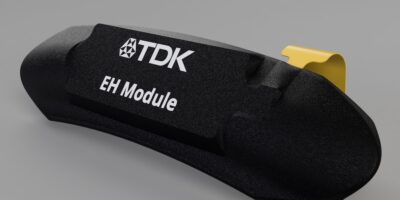Sensor harvests energy in ADAS wheels
Power generation and sensing are combined in the InWheelSense energy harvesting and sensing module for automotive wheels in advanced driver assistance system (ADAS) applications.
The InWheelSense module attaches to the wheel of a vehicle and converts the force of tyre rotation into piezoelectric power and generates battery-less sensing and data collection and transmission from the wheel. According to TDK, delivering an electrical source in this hostile environment is conventionally difficult. The module enables sensing of road surface conditions, wheel alignment, tyre pressure and other conditions in real-time. Smart mobility applications can be implemented when it connects to the roadside infrastructure to help empower smart mobility. The sensors can connect with smart bridges, traffic controls and signage to communicate real-time data and support vehicle-to-pedestrian, vehicle-to-infrastructure and vehicle-to-vehicle networks.
Until now, environmental sensing for ADAS features have largely been driven by perception sensors like lidar and radar, image and infra red cameras. These sensors provide valuable data for ADAS operations but for improved sensing performance during adverse weather or all terrain conditions, non-perception sensors (such as piezo, inertial measurement unit (IMU), ultrasound, and strain gauges) embedded in the tyre or wheel can more accurately digitalise and classify driving and road conditions.
The InWheelSense energy harvesting module uses piezoelectric elements to generate electric power from mechanical motion or force. By placing the device at the boundary between the tyre and the wheel, the module generates electricity using the force received from the road surface as the tyre rotates. It enables scalable power generation according to the load of the driving system by allowing multiple device connections along the wheel’s circumference. It achieves an average continuous power output of 1mW when driving at 65mph / 105km/h. This perpetual source of power is particularly suitable for digitalising driving, road and tyre conditions using a range of non-perception-based sensing, TDK says.
A vehicle’s speed, turning and other changes in operating conditions can cause variations in the electromotive force characteristics of the device. The InWheelSense module can sense various driving conditions using those power changes through analysis of the waveforms from the piezoelectric effect. Waveforms are output when the tyres contact the road surface, so they are continuously generated as the car drives. As the speed increases, the frequency of the waveforms also increases, and when the direction of travel changes, the load on the tyres will change, creating different waveforms that reflect the driving characteristics at that time. A waveform is delivered for each wheel revolution, therefore the InWheelSense module is able to detect not only the speed during driving, but also road surface conditions based on the shape of the output waveform. The different waveforms reflect the driving characteristics at that time.
InWheelSense also allows for real-time collection of data from additional wheel sensors (including accelerometers, barometric pressure and temperature) to the onboard computation unit. This control module platform includes power management, digital compute capacity and low power data transmission using Bluetooth Low Energy. Data can be stored and / or processed through an inference engine in the control module, powered by an edge processor that enables algorithms to make meaningful inferences on the fly. This allows lower-latency control responses without dependency on the cloud during adverse weather conditions. All the power needed to support the data collection, processing, and action (transmission) is supplied by the energy harvesting power generator, confirms TDK.
InWheelSense provides an evaluation kit dedicated for conducting simple evaluations of the energy-harvesting module as a sample that can be attached to existing wheels. This kit enables wireless collection of data outputted from the device and power generation performance without the need for additional equipment.




